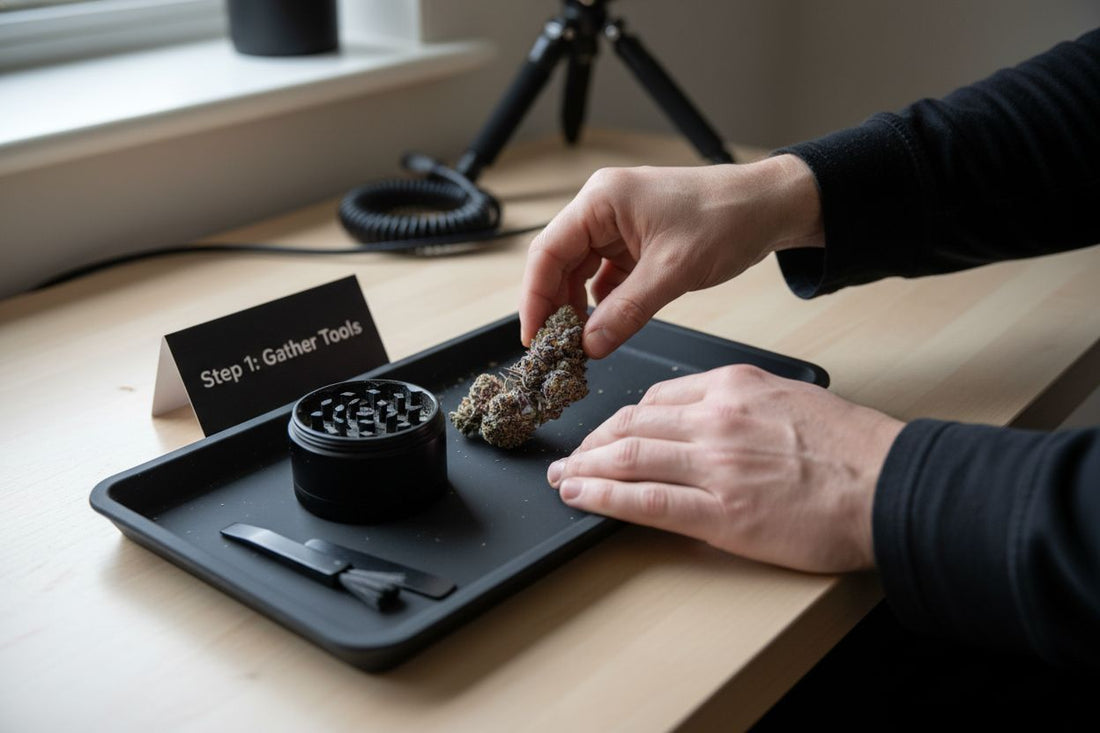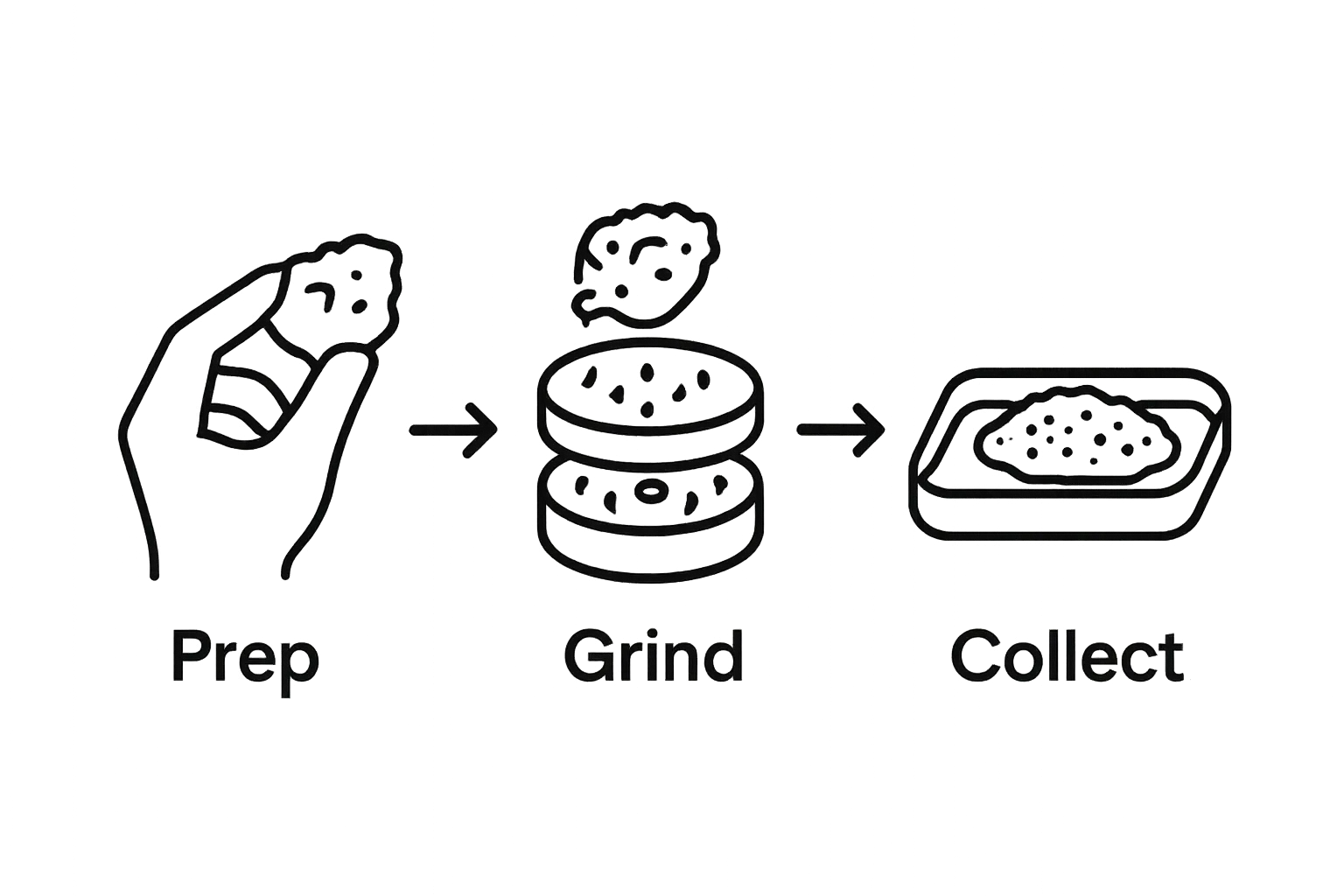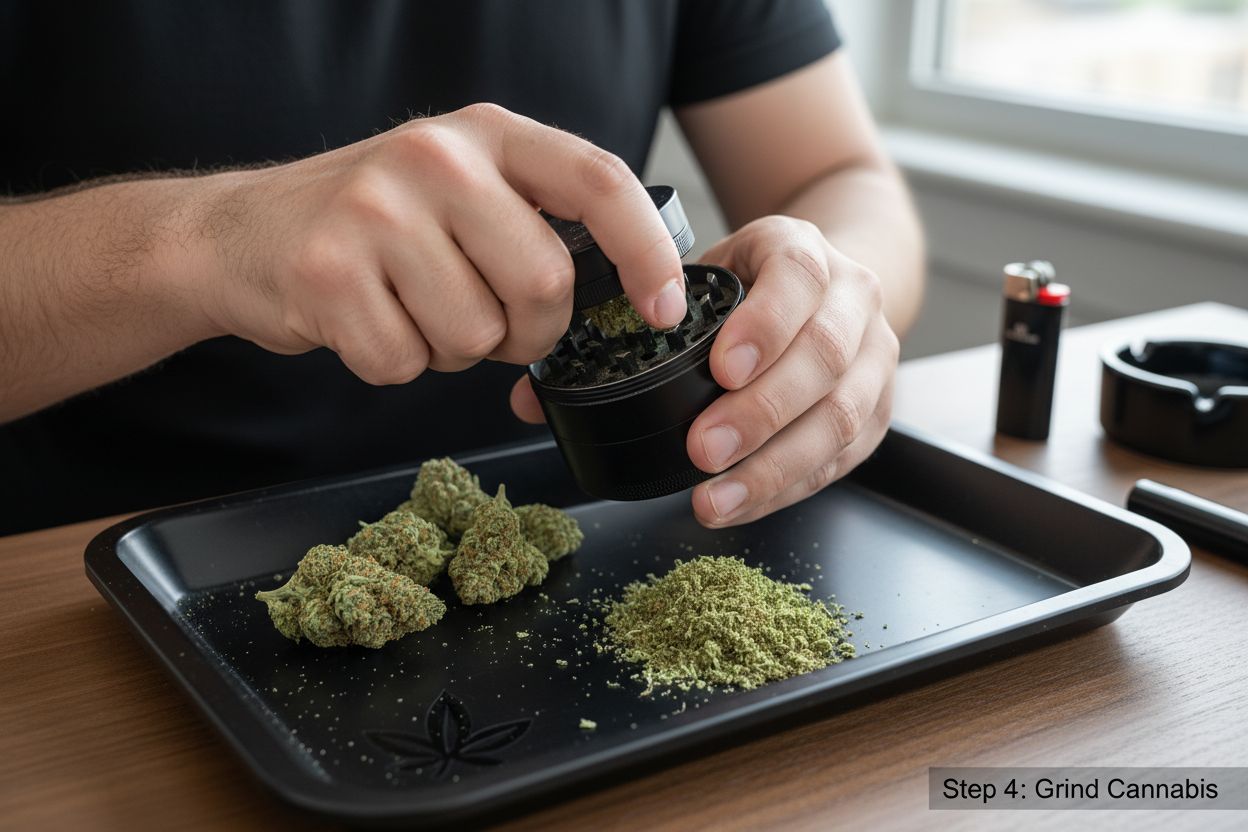How to Grind Cannabis Flower: A Step-by-Step Guide
Written by Trevor

Most people think grinding cannabis is as simple as tossing buds into a grinder and twisting a few times. But it turns out that even a small change can make a massive difference in quality. The right grind can actually enhance flavor and potency, and research shows that particle size distribution from grinding can affect combustion and vaporization characteristics in a big way. So the secret to a better smoke or vape might not be about the strain at all, but about how you break it down before you even light up.
Table of Contents
- Step 1: Gather Your Grinding Tools And Materials
- Step 2: Prepare The Cannabis Flower For Grinding
- Step 3: Choose Your Grinding Method
- Step 4: Grind The Cannabis Flower To Desired Consistency
- Step 5: Inspect The Ground Cannabis For Quality
- Step 6: Store Or Use The Ground Cannabis Flower Properly
Quick Summary
| Key Point | Explanation |
|---|---|
| 1. Use a high-quality grinder | Selecting a durable grinder ensures smooth operation and preserves the quality of your cannabis. Metal grinders are particularly effective. |
| 2. Prepare cannabis before grinding | Remove stems and break down large nugs to ensure even grinding and maintain potency by protecting the trichomes. |
| 3. Choose the right grinding method | Select a manual or electric grinder based on convenience and desired consistency, as this impacts combustion and vaporization. |
| 4. Inspect ground cannabis for quality | Check for uniform texture and trichome visibility to ensure optimal quality, preventing clumps and excessive dust. |
| 5. Store ground cannabis correctly | Use airtight containers and maintain consistent humidity and temperature to prolong freshness and potency. |
Step 1: Gather Your Grinding Tools and Materials
Before diving into grinding cannabis flower, having the right tools and materials ready is crucial for a smooth and efficient process. Proper preparation not only makes grinding easier but also helps preserve the quality and potency of your cannabis.
Your grinding toolkit should include several key items that will make the process seamless. First and foremost, you’ll need a high-quality cannabis grinder. While manual grinders are most common, electric options exist for those seeking convenience. Manual grinders typically come in two or four piece designs, with the four piece version including a bottom chamber for collecting kief - a concentrated form of trichomes.
Choose a grinder made from durable materials like aluminum, titanium, or high-grade acrylic. Metal grinders tend to be more long lasting and provide smoother grinding action compared to plastic alternatives. Some grinders feature magnetic lids to prevent accidental spillage and teeth designed for optimal flower breakdown.
In addition to your grinder, gather some supplementary materials. A clean surface or rolling tray helps contain any loose cannabis and makes the grinding process more organized. If you plan to roll joints or pack bowls after grinding, having a card or small tool for transferring ground cannabis can be helpful. Some users prefer having a small brush to collect any remaining ground material from the grinder’s teeth and chambers.
When selecting your cannabis flower, ensure it is properly cured and not overly moist or dry. Cannabis that is too wet will clump and be challenging to grind, while excessively dry flower might crumble into dust. The ideal moisture content allows the flower to break down evenly without becoming powdery.
Pro tip: If your cannabis seems slightly damp, let it air dry for a short period before grinding. Conversely, if it appears too dry, storing it in a sealed container with a humidity control pack can help restore optimal moisture.
Before beginning, take a moment to inspect your grinder. Ensure the teeth are clean and undamaged, and the grinding mechanism moves smoothly. A well maintained grinder will provide consistent results and extend the life of your tool. With your materials assembled and your workspace prepared, you’re now ready to move on to the actual grinding process.
Step 2: Prepare the Cannabis Flower for Grinding
Preparing your cannabis flower correctly is a critical step that directly impacts the quality of your grinding experience and the eventual consumption. This stage sets the foundation for optimal texture, potency, and overall usability of your ground cannabis.
Start by examining your cannabis flower carefully. Look for any large stems or dense, woody parts that might interfere with smooth grinding. Removing these larger, harder components ensures a more consistent grind and prevents potential damage to your grinder. Gently break down larger nugs into smaller, more manageable pieces using your fingers. The goal is to create loosely connected, roughly similar sized fragments that will feed easily into your grinder.
Handling your cannabis flower requires a delicate touch. Your hands should be clean and completely dry to prevent unnecessary moisture transfer. Moisture can cause cannabis to clump or develop mold, compromising its quality. If you notice any signs of excess dampness, allow the flower to air dry briefly in a cool, dark environment before proceeding.
Temperature and humidity play significant roles in cannabis preparation. Ideally, you want your flower to be at room temperature with a consistent, slightly crisp texture. Overly dry cannabis will crumble too finely, while overly moist cannabis will stick together and grind poorly. You can learn more about optimal cannabis storage techniques to maintain your flower’s ideal condition.
When breaking down your cannabis, be gentle and avoid crushing or compressing the flower too aggressively. You want to maintain the flower’s trichome integrity – those tiny, crystal-like structures that contain the plant’s most potent cannabinoids and terpenes. Rough handling can cause these delicate structures to break off prematurely, potentially reducing the overall potency and flavor profile of your cannabis.
For those working with particularly sticky or resinous cannabis strains, you might find it helpful to briefly refrigerate the flower for 10-15 minutes before grinding. This slight cooling can make the flower slightly less adhesive and easier to separate, without risking moisture condensation.
By the end of this preparation stage, you should have a pile of loosely broken down, evenly sized cannabis fragments ready for smooth, efficient grinding. Take a moment to assess your prepared flower – it should look uniform, free of large stems, and have a consistent, slightly fluffy appearance that suggests it’s perfectly primed for the next step in your grinding process.
Step 3: Choose Your Grinding Method
Choosing the right grinding method is essential for achieving the optimal texture and consistency of your cannabis flower. Different grinding techniques can significantly impact your overall cannabis experience, affecting everything from burn quality to flavor profile.
Manual grinders remain the most popular and versatile option for most cannabis users. These handheld devices typically feature two or four piece designs with interlocking teeth that break down cannabis flower efficiently. Two piece grinders are the simplest, consisting of top and bottom sections where cannabis is ground and collected. Four piece grinders offer additional functionality, with a separate chamber to collect kief - the potent crystalline trichomes that separate during grinding.
When using a manual grinder, technique matters as much as the tool itself. Gently place your prepared cannabis fragments into the top chamber, ensuring you do not overfill. Too much flower can strain the grinder’s mechanism and result in uneven grinding. Rotate the top and bottom sections in a clockwise or counterwise motion, applying gentle pressure. The goal is a consistent, medium fine grind that allows for smooth airflow without becoming too powdery.
Electric grinders provide an alternative for those seeking speed and minimal physical effort. These battery powered devices can quickly process cannabis with minimal user intervention. However, they require careful handling to prevent over grinding, which can turn your flower into an unusable dust. Electric grinders work best with slightly drier cannabis and might not provide the same tactile control as manual options.
Alternative grinding methods exist for those without specialized tools. Some users employ manual techniques like breaking cannabis apart with clean hands or using scissors on a clean surface. While these methods can work in a pinch, they often result in less uniform particle sizes and potential loss of precious trichomes.
Consider your specific use case when selecting a grinding method. Research on cannabis particle size distribution suggests that grinding method directly influences combustion and vaporization characteristics. For smoking, a slightly coarser grind promotes better airflow, while vaporization typically benefits from a more finely ground product.
By the end of this step, you should have a consistently ground cannabis with a texture resembling loose, fluffy ground herbs.
Below is a comparative table summarizing the features, pros, and considerations of different cannabis grinding methods described in the article.
| Method | Description | Pros | Cons |
|---|---|---|---|
| Manual Grinder | Handheld, two or four piece device with interlocking teeth | Good control over consistency; durable | Requires manual effort |
| Electric Grinder | Battery-powered device that grinds cannabis automatically | Fast and easy; minimal effort required | Risk of over grinding; less control |
| Hands | Breaking flower apart manually | No tools needed; quick in a pinch | Inconsistent sizes; potential trichome loss |
| Scissors | Cutting flower into pieces with scissors on a clean surface | Better uniformity than hands | Less precise than grinders; slower |
| Two Piece Grinder | Basic grinder with top and bottom sections | Simple to use; easy to clean | No kief collection feature |
| Four Piece Grinder | Includes chamber for kief collection | Collects kief for extra potency | Slightly more expensive; larger size |
 A good test is to check if the ground cannabis moves freely and can be easily transferred to your preferred consumption method.
A good test is to check if the ground cannabis moves freely and can be easily transferred to your preferred consumption method.
Step 4: Grind the Cannabis Flower to Desired Consistency
Grinding cannabis flower is an art that requires precision, patience, and a nuanced understanding of how different consistencies impact your overall cannabis experience. The goal is to achieve a uniform grind that maximizes flavor, potency, and ease of use across various consumption methods.
Gentle and consistent motion is key when grinding cannabis. Whether using a manual or electric grinder, apply steady, moderate pressure without forcing the mechanism. For manual grinders, rotate the top and bottom sections in smooth, deliberate circles. Aim for approximately 7-10 rotations, which typically provides an ideal medium grind suitable for most consumption methods. Avoid over grinding, as this can transform your cannabis into a fine powder that burns too quickly and loses potency.
The ideal cannabis grind varies depending on your intended use. For smoking joints or pipes, a medium grind works best - loose enough to allow proper airflow but not so fine that it falls through the filter or bowl. Vaporizer users might prefer a slightly finer consistency that increases surface area for more efficient heating. When exploring different cannabis preparation methods, understanding these subtle differences becomes crucial.
Pay close attention to the texture emerging from your grinder. A perfect grind will look like a consistent, fluffy blend with no large chunks or overly powdery sections. The ground cannabis should maintain its structural integrity while being loose enough to distribute evenly. If you notice uneven pieces, briefly return larger fragments to the grinder for additional processing.
Users with four piece grinders have an additional advantage. As you grind, trichome rich kief will naturally collect in the bottom chamber. This concentrated cannabis powder can be saved and used separately or sprinkled onto your ground flower for an extra potency boost. Handle this precious collection carefully, using a small brush or card to gather any accumulated kief.
Technical precision matters, but so does intuition. Each cannabis strain has unique characteristics that might require slight adjustments to your grinding technique. Some strains are more delicate and require gentler handling, while others might be more robust and withstand more aggressive grinding.
By the end of this step, you should have a perfectly ground cannabis flower that looks uniform, feels slightly fluffy, and is ready for your preferred consumption method. The texture should allow for easy manipulation without losing the flower’s essential oils and trichomes.

Step 5: Inspect the Ground Cannabis for Quality
Inspecting your ground cannabis is a crucial final step that ensures you have achieved the optimal grind and preserves the integrity of your cannabis flower. This stage is about quality control, verifying consistency, and preparing for your chosen method of consumption.
Visual and tactile examination provides the most immediate insights into your ground cannabis quality. Spread the ground material on a clean, light colored surface where you can easily observe its characteristics. The ideal ground cannabis should have a uniform, fluffy texture that appears consistent in color and particle size. Look for vibrant colors ranging from deep green to rich amber, which indicate proper curing and preservation of the flower’s natural attributes.
Check for any unexpected elements that might have been introduced during grinding. Remnants of stems, large plant matter, or excessive dust can impact your cannabis experience. A high quality grind will have minimal plant debris and maintain a light, airy consistency that allows for smooth airflow during consumption. Gently run your fingers through the ground cannabis to assess its moisture level and texture. It should feel slightly springy but not damp or overly dry.
The presence of visible trichomes is another critical quality indicator. These tiny, crystal-like structures should appear intact and evenly distributed throughout your ground cannabis. Trichomes are responsible for the plant’s potency and flavor profile, so their preservation is essential. Understanding cannabis quality indicators can help you develop a more discerning eye for these nuanced characteristics.
Potency and freshness are interconnected aspects of cannabis quality. Properly ground and stored cannabis maintains its essential oils and cannabinoid content. If your ground cannabis appears excessively dry or powdery, it might indicate over grinding or extended exposure to air, which can degrade its quality. Conversely, clumpy or overly moist cannabis suggests potential issues with initial preparation or storage conditions.
Light and color can reveal much about your cannabis quality. Healthy, well preserved cannabis typically displays rich, saturated colors without signs of browning or discoloration. Trichomes should have a slightly translucent, crystal-like appearance, reflecting light subtly when moved. Avoid cannabis that looks dull, brownish, or shows signs of mold or unusual discoloration.
By the end of this inspection, you should feel confident about the quality and consistency of your ground cannabis. The material should look uniform, feel appropriately textured, and show no signs of contamination or degradation. A successful inspection means you’re ready to proceed with your preferred method of cannabis consumption.
Use this checklist table to verify the quality and readiness of your ground cannabis flower before storage or consumption.
| Quality Check | What to Look For | Pass/Fail |
|---|---|---|
| Uniform Texture | Fluffy, even particle size, no large chunks | |
| Moisture Level | Slightly springy, not too dry or damp | |
| Trichome Presence | Visible, evenly distributed crystals | |
| No Stems or Debris | Free of stems, woody parts, and large plant matter | |
| Color Consistency | Vibrant green/amber, no dull or brown spots | |
| No Excessive Powder | Minimal dust/fine powder, not over ground |
Step 6: Store or Use the Ground Cannabis Flower Properly
After meticulously grinding your cannabis flower, the final step involves proper storage or immediate use. This crucial phase determines the longevity, potency, and overall quality of your ground cannabis, ensuring you preserve its valuable cannabinoids and terpene profile.
Immediate consumption requires careful handling. If you plan to use your ground cannabis right away, transfer it gently to your preferred consumption tool. For joints, carefully distribute the ground flower evenly along the rolling paper, avoiding compaction that might restrict airflow. When preparing for a pipe or vaporizer, use a clean card or small tool to transfer the ground cannabis, minimizing direct hand contact that could introduce moisture or contamination.
Storage demands strategic consideration to maintain cannabis quality. Temperature, humidity, and light exposure are critical factors in preservation. Choose an airtight container made from opaque, UV protective materials. Glass jars with tight sealing mechanisms work exceptionally well, blocking light and preventing moisture exchange. Ceramic containers with rubber seal mechanisms are another excellent option for short term storage.
Temperature control is paramount. Store your ground cannabis in a cool, dark place with consistent ambient temperature around 60-70 degrees Fahrenheit. Avoid refrigerators or freezers, as temperature fluctuations and moisture can degrade cannabinoid content. Learn more about optimal cannabis storage techniques to preserve your flower’s potency and flavor.
Humidity levels significantly impact cannabis preservation. Aim for relative humidity between 55-62 percent. Too much moisture encourages mold growth, while excessive dryness causes trichome degradation. Consider using humidity control packets designed specifically for cannabis storage. These small sachets maintain ideal moisture levels, preventing your ground cannabis from becoming too dry or developing mildew.
If you are not consuming your ground cannabis immediately, divide it into smaller portions. This approach prevents repeatedly opening your main storage container, which can expose the entire batch to air and potential contamination. Use clean, smaller containers for portioning, ensuring each section remains protected.
Labeling becomes crucial for organized storage. Mark your containers with the strain name, grinding date, and any notable characteristics. This practice helps track cannabis age and ensures you consume older ground cannabis first. By following these storage guidelines, you can maintain the ground cannabis’s potency, flavor, and overall quality for an extended period, ensuring an optimal consumption experience whenever you choose to use it.
Ready to Elevate Your Grind? Discover Premium California Cannabinoid Flower
After learning how the right grind can unlock your cannabis flower’s flavor, potency, and smoothness, the next step is choosing a source that matches your care and standards. Many users struggle to find consistent, lab-tested CBD and THCa flower that retains ideal moisture, flavor, and trichomes for a perfect grind. If you want finely ground cannabis that produces the best results, starting with expertly grown flower is essential. Experience the difference with The THCa Prestige Vault, where every bud is curated for quality and effect, ensuring your efforts in grinding pay off with every session.

Stop settling for dry, harsh, or inconsistent flower that ruins your grinding results. Shop with confidence at California Blendz, where you get organically grown, lab-certified options from California’s Emerald Triangle. Want even more variety? Explore our CBD Sun Grown collection for top-tier CBD-rich strains that grind and perform beautifully. Start with the finest flower and take your experience from good to unforgettable.
Frequently Asked Questions
What tools do I need to grind cannabis flower effectively?
You will need a high-quality grinder (manual or electric), a clean surface or rolling tray, and optionally a card or small tool for transferring the ground cannabis. A small brush can also be useful for cleaning the grinder.
How do I prepare cannabis flower before grinding?
Inspect the flower for large stems and remove them. Break down larger nugs into smaller pieces using your fingers, ensuring the flower is at room temperature and has the right moisture level—slightly crispy but not too dry or damp.
What is the best grinding method for cannabis?
Manual grinders are popular for their control, while electric grinders offer speed. Each method can affect the consistency of your grind, so choose one that aligns with your preferred consumption method—medium grind for smoking and slightly finer for vaporizing.
How can I store ground cannabis flower to maintain its quality?
Use an airtight, opaque container stored in a cool, dark place. Aim for a humidity level of 55-62% by using humidity control packets. Divide your ground cannabis into smaller portions to limit exposure to air each time you access it.
Recommended
- A Step-by-Step Guide: How to Make CBD Infused Oil at Home – California Blendz
- How Is CBD Flower Grown? A Beginner-Friendly Guide to Cultivating Natu – California Blendz
- Decarboxylation Methods: The Old School vs. The New School, A Step by – California Blendz
- How to Find Quality Hemp Flower: A Comprehensive Guide for Buyers – California Blendz








